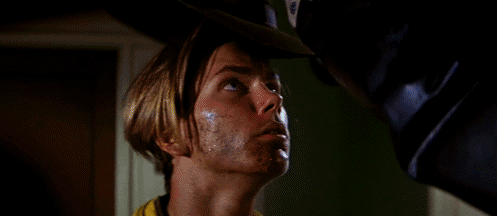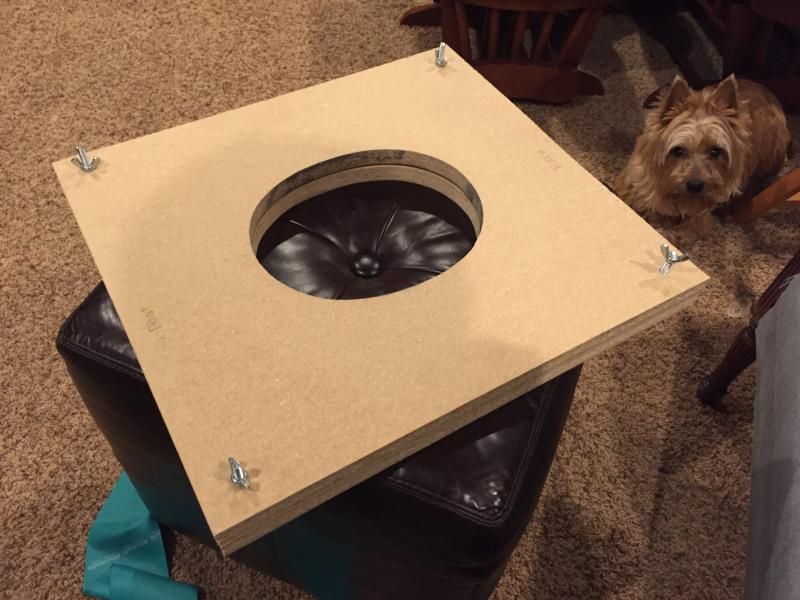Click on any one of the thumbnails for a larger image. I may be making one more hat in the near future. If I do, I’ll try to take more pictures of the process.
I started the hat by making my own block with the tutorial in this thread.

The only thing I would add to that is DO NOT USE PINE. I know I’ve already said this a dozen times in the other thread, but it cannot be stressed too much. Make sure your block is tall enough, too. Mine was about 7 ½ inches tall, and I used a little over 6 inches of it. Other than that, I just eyeballed the shape until I was satisfied. Purchasing a block is always an option if you’re willing to spend an extra $100 or so, but make sure it’s tall enough and has stovepipe sides. I won the flange in an eBay auction for about $50. I think they cost about twice as much, new.
I went to hatsupply.com for some of the materials:
Fur felt dress body, chocolate (darker in person than in pictures)
Felt hat stiffener
Hat lining, white
1 5/8 inch chocolate sweatband, reeded
Ferrule
Grosgrain ribbon #9 (1 1/2 inch), dark chocolate
Block ties (one regular, one large)

The only things I didn’t like from Hat Supply were the ribbon and the sweatband. The quality of the ribbon was great, but the color is all wrong, so I’ve ordered a replacement ribbon from Todd’s (still hasn’t gotten here). The sweatband feels pretty cheaply made, but it does the trick.
I also got two items from Michael’s:
Printable silk
¼ inch white ribbon
Everything else, I already had on hand:
Sewing needles
Brown and white thread
Iron & ironing board,
Large kitchen pot
Sandpaper (400 grit, 600 grit, go finer if you can)
Scissors
Computer with Adobe Illustrator and printer (I only used this for the logo)
Pushpins
Extremely thin towel (an old t-shirt with no logos would have worked for this)
Pliers
Chalk
Ruler
Spray bottle or paintbrush
Everything I knew going into this I learned from tutorials here and at the Fedora Lounge:
AB Deluxe
JW Hats
The rest, I learned just by doing it.
The first thing I did was get some water boiling in the biggest kitchen pot I have. While I waited for it to boil, I applied stiffener to the felt with a clean paintbrush. I poured about ½ cup into a small dish, and put it on the underside of the entire body. Next time, I’ll try applying it with a spray bottle, and I’ll probably use more stiffener, too.
After the stiffener was in the felt and the water was boiling, I set the body right-side-up on the top of the pot, and left it there for 5 min. I took it off, and stretched it over the block. The felt felt funny after steaming it (read that again if you’re having trouble—it makes sense). I can only describe it as a combination of felt, rubber, and clay. It still had the touch of a soft felt, but it stretched liked rubber, and held its new molded position like clay.
With an Indiana Jones fedora, you’ll have to turn some of the brim into crown. It’s really unavoidable. I pulled down evenly all round as best I could.

When this wasn’t enough, I started pulling down one side at a time, and pinning it with push pins about ¼ inch lower than my intended break between the crown and the brim. I used 2 pushpins on each side to share the load so the felt wouldn’t tear.

After I had pins at 12, 6, 3, and 9 o’clock (in that order), I pinned the corners. Than I started filling in the gaps until I had about 20 pins in it all around. At this point, I put the block tie above the pushpins (about 6 ¼ inches from the top of the crown) and tied it down tight. If I’d put the pushpins at the point where I wanted the break, I’d have been in trouble, because the tie would have ended up higher than the intended break. With the tie in place, I removed the pushpins, and let the felt dry and cool.

This is the perfect time to work on the ribbon, sweatband, and liner (if you choose to add a logo).
There are a number of ways you could make the bow. I prefer to do it with as few pieces of ribbon as possible, and I’ve successfully gotten that down to only 2 pieces of ribbon; one piece for the “knot” of the bow, the other piece for the rest. I folded and ironed the ribbon like so…

Than I took the middle of the bow and pinched it horizontally like Marc did to put a stitch in it. This is what gives you the “Flying V” as it’s come to be known. The “knot” of the bow was made by folding the finished edges (normally the top and bottom of the ribbon) inside, making a small ring, and stitching it in the back. Than I slide the “knot” over the stitch that I had made in the bow. I left the ribbon like this until I was ready to sew it on.

If you’re confident that you can measure the sweatband correctly before you take the hat off the block, cut the sweatband to the right size (give yourself an extra ½ inch of reed as you cut the sweatband). I poked holes in the ends of the sweatband with a pushpin so that I wouldn’t have to force a sewing needle through. Make sure you line the two ends up as you poke holes; you don’t want them to be uneven. I had all the extra reed sticking out one side of the sweatband, and clamped the ferrule to that side of the reed with a pair of pliers. Than I pushed the ferrule into the sweatband until only half the ferrule remained exposed. At this point, I cut off all the excess reed sticking out the other end of the sweatband. I finessed the protruding end of the ferrule around the reed, inside the other end of the sweatband and clamped it again using the pliers. To sew the ends of the sweatband, I started at the reed and worked my way up. I had the diagonal stitches on the visible side, and the horizontal stitches on the suede side. When I got to the tip of the sweatband, I came back and finished the stitches at the reed. Using diagonal stitches going up and coming down gave me a nice XXX pattern on the visible side on the sweatband.

I bought some ¼ white ribbon from Michael’s for the bow in the back of the sweatband. I tied off and frayed the ends on the ribbon on purpose. After ironing the bow flat, I sewed it to the sweatband. I would have glued it, but I didn’t have any glue, and was too impatient to go out and get some. I think hot glue would have worked best.
If you’re interested in putting a logo in your hat, there’re probably a few ways you could do it. I went out looking for some printable cotton, but all I could find was printable silk. I’m sure any printable fabric would work for this. One thing you’ll probably want to avoid is printable transfers. Everyone at the craft store expressed doubts about whether or not transfers would hold up on satin, so I figured it would be best to stay away from transfers. Anyway, I printed the logo on the silk. I had to do a few test runs to make sure I got the color right. Once I was satisfied, I cut the logo out with ½ inch lip around the edge of the logo. I peeled the silk off the paper (carefully) and folded the edges back and ironed them flat. The silk didn’t like the iron, but it was necessary. Just be sure to use a very low heat setting, and make quick passes with the iron. With the edges folded back, and ironed flat, I sewed it into the liner (top of the logo at the back of the hat). The diamond shape worked out pretty good for me. It might have made my life easier to stitch all four corners down before I actually went to sew the whole thing to the liner.


It couldn’t hurt to let the felt sit on the block longer than necessary. I sat around for three hours watching “Der Untergang” with the felt on the block. It spent about 6 hours total on the block (probably much longer than necessary, but I liked the results). Once I took it off, the brim was a warped mess. I flattened it out on the ironing board with the heat and steam all the way up, but I kept a thin towel between the iron and the felt. I didn’t get it entirely flat, but it was a huge improvement since I’d started.

At this point, I took the sandpaper to the felt. I started pouncing with 400 grit, moved up to 600 grit, than expressed my frustration that the local Home Depot didn’t have anything finer than 600 grit. The hobby store didn’t even have anything that fine. I would have gone all the way to 2000 grit like Marc if I could have found the sandpaper. Either way, 600 grit got rid of most of the fuzz, and I’m happy with it. You can see that it’s still fairly smooth, but I recommend searching for finer grit than I used.

I didn’t use a hat jack to cut the brim. I measured out a dimensional cut (2 ¾ front and back, 2 ½ right and left) and marked it on the brim. I made 2 5/8 inch marks at the 45 degree points, than 2 9/16 inch and 2 11/16inch marks at the appropriate midpoints. Last, I eyeballed one more set of midpoints all around the hat (32 marks around the hat total). Than I just played “connect the dots” on the top of my brim (with curved lines, of course). This is the part you need steady hands for. I cut the brim around the line with a pair of sharp scissors. I recommend cutting on the outside edge of the line, or about 1/16 inch wider than your intended cut. This will allow you to make mistakes and smooth it out. I’m still working on smoothing out a few rough spots on my brim with sandpaper.

Flanging the brim was one part that had me stumped. I thought I could just put the hat in the flange, iron it down, and eventually I’d have a curled brim. Not so. I learned that I could drape that same towel I used earlier over the felt, lightly tie it down to the flange with a block tie, and pull the freely hanging parts of the towel down until it held the entire brim flat against the flange. Once the felt was tight against the flange, I tightened the block tie and ironed the brim with high heat and high steam for about 15 minutes, than let it cool for about a half hour.

When I removed the towel, the brim held its shape.

The first thing I put on the hat was the sweatband. It was a little frustrating trying to sew through the material sewn onto the back of the sweatband only because you’re sewing in a place that’s hard to reach. It’s not important that these stitches look pretty, because you’ll never see them, but you want to make sure you’re not cheating yourself. I thought I could make the stitches really wide, but I quickly found out it wouldn’t hold the sweatband in place. You also want to make sure you put the sweatband on as low as possible. If you put the sweatband on too high, your forehead will touch the felt as you’re wearing the hat. This was my second mistake in sewing the sweatband on. By the time I finished, I’d sewn the sweatband on three times.

Since the ribbon and bow were more or less finished, all I needed to do is make sure I had it sized right. I cut the ribbon so that it would fit snug around the hat and end in the middle of the “knot”. I slid the “knot” forward and stitched the end of the ribbon to the back of the bow, than slide the “knot back over it to cover it up. I put a stitch in each of the four corners to hold the “knot” in place, and slide the whole thing over the hat. Each loop of the bow gets two stitches (one in each corner). I put one stitch on the backside of the “knot” to hold it down at the brim. I made this stitch in a way that it won’t be visible. All the other stitches in the ribbon, I make horizontally, and very short. The rest of the ribbon got a total of five stitches: one on each corner of the hat, and one opposite the ribbon. I made the low stitches by pulling the reeded edge of the sweatband away from the felt and sewing right at the base of the crown. To stitch the tops of the bows, I needed to flip the sweatband inside out.
You can barely see the stitch in this picture, but it’s there. You’re not going to need the ribbon to snag on a tank cannon to save your life, so there’s no point in making large stitches to hold them in place. Small stitches will do fine, and they look better.

The liner can be the easiest thing to install. I stuck it in the hat, observed how much stuck out below the sweatband, and cut off the excess satin with a pair of scissors. From here, there are two ways to secure it in place: glue or stitches. I haven’t secured it at all yet, but I intend to stitch it. This requires getting the sewing needle into the felt without going all the way through. I’ll do this by pushing temporary “bashes” into the sides so they the needle has something to catch. The photo is the liner of a vintage Stetson of mine.

If you’d rather glue it (this seems to be common practice even for well-made hats today) you could hold it in place with a few (maybe four) very small dabs of glue (one on each corner). You would have to flip the sweatband inside out to do this. That way, once the sweatband is back in place, it will cover the spots that are glued. If you do large amounts of glue, it could show on the outside of the hat. If you press the liner too hard against the glue as it cools, you could affix it too well. You might end up tearing the felt if you ever try to remove the liner for a reblock.
At this point, my hat was finished and ready to be bashed. I had trouble getting the bash to stay in place in this felt without a little steam, but we’re all pretty familiar with bashing, so I won’t get into that.
I hope I helped out anyone who might be interested in trying this himself. If you’ve got any questions, or if anything was unclear, let me know and I’ll try and fix it.




I tried reshaping the hat with steam a few months later with disastrous results, so I reblocked it. While I was at it, I gave it a complete overhaul, got some 1000, 1500, and 2000 grit sandpaper, and one of Todd's replacement ribbons. This is how I meant for it to look the first time.





I added some Fuller's Earth before the Indy IV Premiere.


































